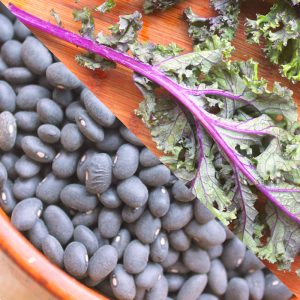Originally posted on
Meatless Monday: Eating to Save the World
World Vegetarian Day was October 1, but we keep the party going all month long — October is Vegetarian Awareness Month. Just in time, too, because honey, people need some of both. As a lead-up to World Vegetarian Day, I spoke to two different groups about my favorite subject — eating to save the world.
That sounds like a tall order. Can what we eat end sickness, war, global hunger or environmental catastrophe, basically your Four Horsemen of the Apocalypse? I believe it’s possible. As I say in my book, “Feeding the Hungry Ghost,” change your diet, then change your life, then change the world. Any move towards a greener diet results in a stronger, healthier you and a stronger, healthier planet.
A diet of fruits and vegetables, whole grains and beans, nuts and seeds results in longer, healthier lives, according to a June JAMA study. Stanford University finds a produce-driven diet helps the planet live better, too. Growing produce generates less carbon emissions and uses less water than raising livestock and takes less of an environmental toll. Livestock production is also one of our greatest causes of deforestation, which is making for a hotter, less sustainable planet. And a new University of Minnesota study finds if we switch farmland dedicated to livestock production and livestock feed to food for us, we’d have a recipe to end global hunger.
The possibilities are so amazing, I get revved when I do these presentations — and I’m not a big talker by nature. I am, however, a very, very good listener. The best part for me comes after my presentation, when I can hear what’s going on with people in the audience. What they tell me is they’re overwhelmed — food allergies, environmental concerns, a kid who only eats chicken nuggets, no time. I try to offer people some real concrete takeaway, including my number one multitasking tool — eat less processed, more produce. I show how to add greens to your favorite foods, the ones you already turn to for comfort. I provide plant-based incentive by make something vegan to sample — free eats that taste good and do both you and the planet great good, too.
We often feel helpless in our daily lives — God know I do. Superhero? Not so much. No obvious superhero power or even fab superhero gear. And yet, we all have the power to save the world with something we do every day — by choosing what we eat.
Like I said, we could use some joy and awareness, and now’s the time. Today is Meatless Monday, tomorrow is World Vegetarian Day, October is Vegetarian Awareness Month. Let’s observe, honor and celebrate it by remembering eating is an essential, life-sustaining act sustaining act, for you — and if you do it right, for the planet, too.

Black Beans and Kale Save the World
Ingredients
- 3 tablespoons olive oil
- 2 onions chopped
- 4 garlic cloves chopped
- 1 sweet red pepper chopped
- 1 hot pepper like a jalapeño, chopped
- 12 ounces dried black beans cooked with 2 garlic cloves and 2 bay leaves
- OR 2 15-ounce cans prepared black beans with their bean broth
- 1 tablespoon tomato paste
- 2 teaspoons smoked paprika
- 2 tablespoons sherry vinegar OR 1 tablespoon cider vinegar
- 1 head kale or Swiss chard sliced into skinny ribbons*
- sea salt to taste
Instructions
- In a large soup pot, heat olive oil over medium-high heat. Add onions and cook, stirring, until they start to sweat, about 5 minutes. Add garlic and both the sweet and hot pepper.
- Stir to combine and reduce heat to medium. Cook the vegetables, stirring occasionally, for another 15 minutes, until they're softened and aromatic.
- Add the black beans. Stir to combine. Reduce heat to medium, set the pot lid on halfway, leaving a little steam vent.
- Cook the beans for an hour, longer if you've got the time. Add a quarter cup of water if necessary. The beans should be thick but not over-dry. The goal is a divine beanly sludge.
- Stir in the tomato paste, smoked paprika and sherry or cider vinegar. Remove from heat.
- Add the chiffonade of kale or chard by the handful. Stir gently, letting the greens wilt into the beans.
- Season with sea salt to taste.

Leave a Reply